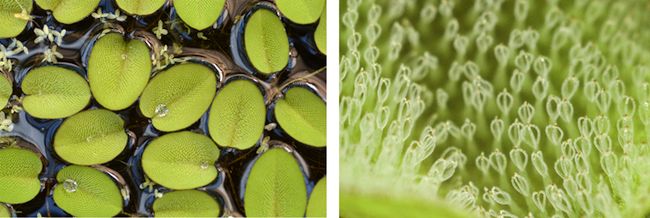|
|
|
|
|
|
| Researchers at Jilin University, China, reviewed recent progress in the study of Salvinia leaves and their artificial replicas. |
CHANGCHUN, CHINA, Sept 16, 2021 - (ACN Newswire) - Several plants and animals have evolved surfaces with long-term (i.e., days to months) air-retainability to prevent wetting and submersion. One example is Salvinia, a plant floating on water. The secret "how do they maintain an air-mattress" has been unraveled by researchers.
 | | Salvinia leaves and the eggbeater structures |
Researchers at Jilin University reviewed recent progress in the study of Salvinia leaves and their artificial replicas. "Salvinia has complex multicellular hairs on the upper side of its leaves, and each group of four hairs is connected at the terminal ends, forming an eggbeater structure. The hairs are coated with hydrophobic wax crystals, while the patches at the terminal ends of the hairs lack wax crystals and are, therefore, hydrophilic. These features make the air-water interface more stable, exhibiting long-term air-retention ability," says author Huichao Jin of Jilin University in Changchun, China.
Since the air-retention ability of Salvinia leaves was discovered, researchers began to fabricate artificial Salvinia leaves and investigated their potential applications. However, the complex eggbeater structures present a difficult challenge for traditional manufacturing methods. In the past decade, photolithography, direct laser lithography, chemical vapor deposition, electrodeposition, electrostatic flocking, 3D printing, chemical etching, and plasma etching recently have been developed for fabricating Salvinia-inspired structures. However, the complex structures make many of these techniques unable to replicate the fine structures. Although direct laser lithography and 3D printing techniques succeed in fabricating fine structures, they cannot fabricate the hydrophilic tips at the end of hairs. Therefore, it is still challenging to fabricate artificial Salvinia leaves.
The robust air-mattress in Salvinia structures acts as a physical barrier for water to reach the substrate. This inspires many engineering applications, including drag reduction, water harvesting, evaporation, and repellence, oil/water separation, and thermal insulation. These works are currently limited to early laboratory demonstrations. There are still challenges in the development of artificial surfaces suitable for the complexity and variability of the real environment.
Jin and his colleagues are exploring the potential of Salvinia structures in preventing medical bacterial infection. "The air-mattress acts as a physical barrier for water to approach the substrate, and it can also act as a physical barrier for preventing bacteria reach substrates," says Jin. He points that traditional antibacterial surfaces involving antibiotics may cause drug resistance while the artificial Salvinia-inspired surfaces are free of antibiotics. Employing Salvinia structures to prevent medical bacterial infection may be a promising strategy.
Article details:
Jin et al., "Small structure, large effect: Functional surfaces inspired by Salvinia leaves" Small Structures (2021) https://doi.org/10.1002/sstr.202100079
Contact:
Dr. Huichao Jin
Jilin University
Email: jinhc@jlu.edu.cn
Press release distributed by Asia Research News for Jilin University.
Topic: Press release summary
Source: Jilin University
Sectors: Materials & Nanotech
https://www.acnnewswire.com
From the Asia Corporate News Network
Copyright © 2025 ACN Newswire. All rights reserved. A division of Asia Corporate News Network.
|
|
|
|

|
|
|
| |
Latest Press Releases
A New Benchmark for Specialized Technology Stocks in Hong Kong! CiDi's Listing Marks a New Chapter in Commercial Intelligent Driving
Dec 19, 2025 10:30 HKT/SGT
|
|
|
Air T, Inc. Announces Closing of Regional Express Acquisition
Dec 19, 2025 06:10 HKT/SGT
|

|
|
MHI Participates in Demonstration Testing of Vehicle-Infrastructure Integration System for Autonomous Buses in Shimotsuke City
Friday, December 19, 2025 2:24:00 AM
|

|
|
NEC and emaratech Collaborate on Biometric Smart Gates Supporting UAE Airport Operations
Friday, December 19, 2025 2:06:00 AM
|

|
|
Fujitsu to showcase mobility and physical AI tech at CES 2026
Friday, December 19, 2025 1:42:00 AM
|

|
|
Kirin and Fujitsu elucidate a novel gut-brain axis mechanism of citicoline for the first time worldwide through AI-based analysis and experimental validation leveraging drug discovery DX technology
Friday, December 19, 2025 1:06:00 AM
|

|
|
TANAKA PRECIOUS METAL GROUP and TANAKA MIRAI Lab. Released Their Fourth Collaborative Musical Work with Sound Wellness Lab (Della): "Precious Metal Orchestra - A Musical Voyage through the Sound of Precious Metals for Christmas" now available for streaming. 
Thursday, December 18, 2025 9:00:00 PM
|

|
|
Focus Graphite Announces Final Results From 2022 Drill Program at Lac Tetepisca; West Limb Extends Mineralized Strike to 8 KM
Dec 18, 2025 18:09 HKT/SGT
|

|
|
Spritzer MerryLand Returns This Year-End, Bringing Magical Festive Cheer to Taiping
Dec 18, 2025 17:44 HKT/SGT
|

|
|
PropertyGuru Asia Real Estate Summit spotlights PropertyGuru Week 2025 with conversations on 'Trusted Marketplaces and Thriving Communities'
Thursday, December 18, 2025 9:00:00 AM
|

|
|
|
|
More Press release >> |
|
|
|